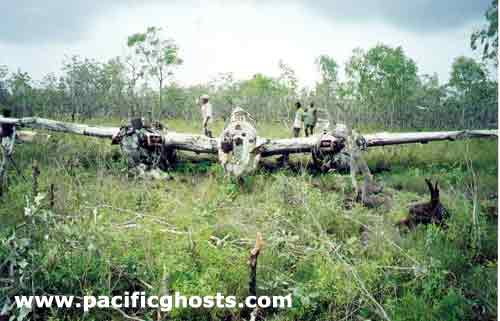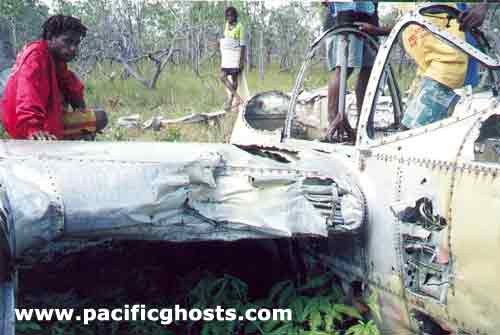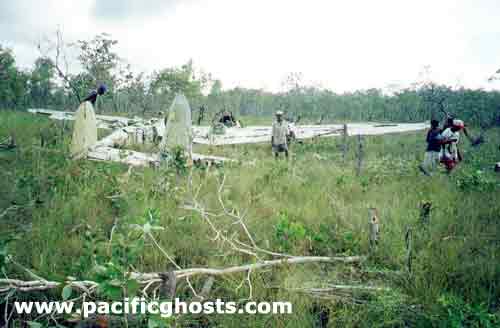|
|
| Missing In Action (MIA) | Prisoners Of War (POW) | Unexploded Ordnance (UXO) |
| Chronology | Locations | Aircraft | Ships | Submit Info | How You Can Help | Donate |
|
| USAAF 5th AF 475th FG 433rd FS   Bill Thompson 1980    Pacific Ghosts 2001  Gary Larkins 2002 |
Pilot 2nd Lt. John Clay Smith, O-736392 (survived) Portsmith, OH Force Landed September 2, 1943 MACR none Aircraft History Built by Lockheed Aircraft Corporation (LAC) in Burbank. Constructors Number 1049. Delivered to the U.S. Army Air Force (USAAF) as P-38H-1-LO Lightning serial number 42-66538. Disassembled and shipped overseas and reassembled. Wartime History Assigned to the 5th Air Force (5th AF), 475th Fighter Group (475th FG) "Satan's Angels", 433rd Fighter Squadron (433rd FS) "Possum". No known nickname or nose art. Mission History On September 2, 1943 took off from North Borio Airfield (Dobodura No. 15) piloted by 2nd Lt. John Clay Smith on a mission to escort B-25D Mitchells over Wewak. Over the target, Smith claimed two enemy aircraft shot down, a Ki-43 Oscar and an unknown twin engined aircraft. After the air combat, Smith got lost and thought he was flying south of Wewak, and believed his compass was faulty. He then attempted reach Marilinan and was in contact with Benabena via radio but became lost, ran out of fuel and force landed in a swamp near Arufi near the Fly River. During the landing, the P-38 impacted several small trees before it stopped but was otherwise undamaged in the crash. Fate of the Pilot Unhurt in the landing, Smith removed the plane's gun camera, so he would have proof of his two victory claims when he returned to base. He walked for two days before reaching the Wassi Kussa River, and followed it to the Gulf of Papua. Finding a villager, he was transported in his canoe to a small island and told about a radio outpost on Saibai Island. Together, Smith and the villager departed in a small boat and 36 hours later reached the island. On Saibai Island two Australian Army wireless operators greeted him and radioed for a Royal Australian Air Force (RAAF) Catalina to transport him to Port Moresby arriving on September 15, 1943. Smith was admitted to the 161st Evacuation Hospital until released on September 21, 1943 and that afternoon was flown back to his squadron at Dubodura Airfield. After returning to duty, he was instructed to write a full report of about his escape. Afterwards, Smith returned to duty but was killed on November 9, 1943 piloting P-38H Lightning 42-66596. Wreckage This P-38 remained in situ in kunai grass where it force landed near Arufi. After the crash, the machine guns were removed by an Australian Patrol Officer (kiap) in the area. Frank Pyne recalls: "I worked for the Australasian Petroleum Company in PNG during 1953/4. One of our base camps was on the Wassi Kussa river about 12 miles downstream from Arufe Mission. We knew of the P-38 wreckage near the mission and on one occasion a local brought in an aluminum oxygen tank to ask our workshop to cut it in half to make rice cookers. I didn't ever visit the wreckage. Another of our surveyors had some .50 calibre ammunition from the wreck." Sandy Brown reports: "I visited the P-38 at Arufe, Papua New Guinea in October 1985. The plane was put down in a swamp. When I visited the area was above the river level and in what is known as savanna grassland. The trees that damaged the plane on its forced landing were no longer evident and new trees have grown around it. The solid steel armor plate was being used as a church bell in Arufe village at the time. I was told that the machine guns were removed from the plane by Australian Government Patrol officers who took them as souvenirs." During the early 2000s, foreign salvagers sought to recover this aircraft. In 2001, Robert Jarret visited the crash site. In 2002, Gary Larkins overflew the site. Until March 2002, the wreckage remained in situ. Recovery During 2002, the nearly complete P-38 was illegally recovered by an Australian "Rex Barber" a pseudonym for World War II pilot 1st Lt. Rex T. Barber. The wreckage was cut into pieces with a gas torch, and shipped to Lae. During March 2002, the aircraft was impounded before being exported to Australia. Sadly, this once aircraft had both wings and boom hastily and unprofessionally cut to expedite the illegal recovery. Since being impounded, the contain has since disappeared, and its whereabouts are unknown. At the time, the theft of this stolen aircraft under investigation by PNG authorities. Afterwards, the wreckage was illegally exported or otherwise disappeared from Lae. The fate or location of this aircraft today is unknown. References USAF Serial Number Search Results - P-38H-1-LO Lightning 42-66538 E&E Report No. 26 - 2nd Lt. John Clay Smith pages 19-21 Plans to Steal P-38H Lightning 42-66538 Foiled 2002 Possum Clover and Hades reports Smith's force landing Flightpath Magazine "Arufi P-38" by Michael Claringbould Contribute Information Are you a relative or associated with any person mentioned? Do you have photos or additional information to add? Last Updated November 22, 2025 |
P-38 Photo Archive |
| Discussion Forum | Daily Updates | Reviews | Museums | Interviews & Oral Histories |
|